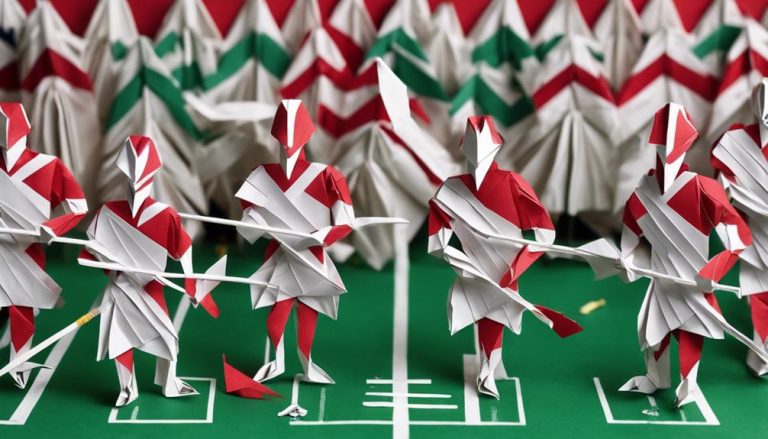General Rules of Sporting Clays
Are you aware of the fundamental guidelines that govern the sport of sporting clays? From safety protocols to scoring systems and etiquette, there are essential rules to follow for a smooth and enjoyable experience on the range. Understanding the nuances of shooting stance, equipment requirements, and course layout can significantly impact your performance. Stay tuned to discover key insights that will elevate your understanding of the intricacies of this popular shooting sport.
Safety on the Range
Ensure you always handle your firearm safely on the range to prevent accidents and promote a secure shooting environment. Following safety protocols and range rules is crucial for a successful and enjoyable sporting clays experience. When you arrive at the range, familiarize yourself with the specific rules and guidelines in place. Always keep your firearm pointed in a safe direction, with your finger off the trigger until you are ready to shoot. Make sure you know how to safely load and unload your gun, and never leave it unattended.
Respect the range officers and listen carefully to their instructions. They are there to ensure everyone's safety and to help maintain a controlled environment. Keep your firearm unloaded until it is your turn to shoot, and never shoot beyond your designated station. Being aware of your surroundings and staying attentive can prevent accidents and create a harmonious atmosphere for all participants. By following safety protocols and range rules diligently, you contribute to a liberated and secure shooting environment for everyone.
Scoring System Overview
As you progress through your sporting clays experience, understanding the scoring system is fundamental to gauging your skill and performance on the range. Here are some key points to keep in mind:
- Scoring Techniques: Utilize different strategies to maximize your score, such as focusing on consistency or taking calculated risks.
- Competition: Embrace the competitive spirit of sporting clays by aiming to outperform others while still enjoying the camaraderie of the sport.
- Scorecard Management: Keep track of your scores meticulously to identify areas for improvement and celebrate your successes.
- Tiebreakers: Be prepared for tiebreaker situations where precision and nerve can make all the difference in determining the winner.
- Learning from Each Round: Use your scores as valuable feedback to refine your technique and mental approach in subsequent rounds.
Mastering the scoring system not only enhances your overall experience but also adds an element of excitement and challenge to your sporting clays journey. So, dive into the intricacies of scoring and elevate your performance on the range.
Etiquette and Conduct
Upholding proper etiquette and conduct in sporting clays is essential for fostering a respectful and enjoyable environment among participants. When engaging in this exhilarating sport, remember that sporting clays, much like other shooting disciplines, has its own set of unwritten rules that contribute to the overall experience. Firstly, proper attire is crucial. Dress comfortably, ensuring that your clothing allows for ease of movement and doesn't hinder your shooting technique. While there's no need for formal wear, opting for appropriate attire shows respect for the sport and fellow participants.
Furthermore, respectful behavior is paramount. Treat others with kindness and consideration, whether you're a seasoned shooter or a beginner. Encourage your fellow shooters, offer assistance when needed, and always adhere to safety protocols. Remember, the camaraderie in sporting clays is just as important as hitting those clay targets. By embodying these principles of proper attire and respectful behavior, you contribute to a positive atmosphere that enhances everyone's enjoyment of the sport.
Shooting Stance and Techniques
For optimal performance in sporting clays, mastering your shooting stance and techniques is crucial. To excel in this exhilarating sport, here are some key tips to enhance your skills:
- Proper Grip: Ensure a firm yet comfortable grip on your shotgun. Your grip should be secure but not overly tight, allowing for better control and recoil management.
- Sight Alignment: Focus on aligning your dominant eye with the rib of the shotgun and the target. Proper sight alignment is essential for accurate shooting and hitting your mark consistently.
- Stance Stability: Maintain a balanced and stable stance by distributing your weight evenly on both feet. This will help absorb recoil and provide a solid foundation for a smooth follow-through.
- Body Positioning: Position your body slightly forward, leaning into the shot while keeping your head down on the stock. This posture promotes a fluid swing and follow-through.
- Smooth Swing: Practice a fluid and controlled swing, tracking the target seamlessly with your shotgun. A smooth swing, combined with proper grip and sight alignment, is key to hitting fast-moving targets with precision.
Mastering these shooting stance and techniques will elevate your performance in sporting clays, empowering you to achieve greater success on the course.
Equipment and Gear Requirements
Ensuring you have the right equipment and gear is essential for excelling in sporting clays, as they play a critical role in enhancing your performance and overall shooting experience. Proper gear maintenance is key to keeping your equipment in top condition. Clean your shotgun regularly, ensuring smooth operation and longevity. When it comes to shooting apparel, choose comfortable clothing that allows for easy movement and doesn't restrict your swing.
Optics selection is crucial for improving your aim and target acquisition. Consider red dot sights or scopes based on personal preference and shooting style. Experiment with different choke preferences to find what works best for you. Chokes can significantly impact shot pattern and range, so it's essential to select the right one for each station.
Investing time in understanding your gear and equipment can elevate your performance on the sporting clays course. Embrace the process of gear selection and customization to suit your individual needs and preferences.
Course Layout and Targets
Get ready to experience the heart-pounding thrill of navigating through a course designed to test your skills to the max. With strategic target placement, a variety of shooting stations, and challenging target combinations, each station promises an adrenaline-packed adventure. Take on the challenge, embrace the excitement, and aim for greatness on every shot.
Target Placement Strategy
When designing a sporting clays course, meticulous consideration of target placement is essential to create a challenging and engaging experience for shooters. To maximize the thrill and test shooters' skills, here are five key elements to keep in mind:
- Varied Distances: Set targets at different distances to challenge shooters' depth perception and judgment.
- Natural Obstacles: Utilize trees, bushes, and terrain features to create natural obstacles that require shooters to adapt their shooting positions.
- Hidden Targets: Conceal targets partially behind obstacles to simulate real hunting scenarios and test shooters' ability to track and acquire targets quickly.
- Changing Elevations: Place targets at varying heights to require shooters to adjust their aim and master elevation changes.
- Crossing Targets: Introduce targets that cross paths to challenge shooters' timing and coordination while aiming.
Varied Shooting Stations
To enhance the excitement and challenge for shooters, the layout of varied shooting stations in a sporting clays course must be strategically planned to test a wide range of shooting skills and techniques. Station positioning plays a crucial role in achieving this goal. By strategically placing stations at different points along the course, shooters are forced to adapt to varying shooting angles, distances, and target trajectories. This setup ensures that participants face a diverse set of challenges, keeping the experience fresh and engaging. Shooting angles add another layer of complexity, requiring shooters to adjust their stance, mount, and swing to successfully hit the targets. The dynamic nature of varied shooting stations keeps shooters on their toes, offering a truly liberating and exhilarating experience.
| Station | Positioning | Shooting Angles |
|---|---|---|
| 1 | Open field | Wide and crossing |
| 2 | Wooded area | Teal and incoming |
| 3 | Pond side | Battue and quartering |
Challenging Target Combinations
Crafting a challenging sporting clays course with intricate target combinations demands meticulous planning and a deep understanding of how each target's placement influences the shooter's experience. When considering target trajectory and shooting order, the course designer must aim to surprise, challenge, and inspire the shooter. Here are five key elements to consider when designing target combinations:
- High Tower to Low Rabbit: This combination tests both the shooter's ability to adjust to different target heights and their skill in hitting fast-moving targets.
- Simultaneous Crossers: Two targets crossing paths simultaneously demand quick reflexes and precise timing.
- Teal Target Overhead: A teal target launched overhead can simulate birds flying away, requiring shooters to lead the target effectively.
- Driven Target Crossing: Mimicking a driven game bird, this target requires shooters to quickly acquire the target and follow through smoothly.
- Quartering Targets: These targets simulate birds flying diagonally, challenging shooters to adjust their lead and timing.
Squad Formation Rules
Understanding the importance of proper squad formation rules is crucial for a successful sporting clays experience. Squad dynamics and team strategy play a significant role in achieving peak performance on the course. When forming your squad, consider each member's strengths and weaknesses to maximize your collective potential. Utilize formation tactics to adapt to different target presentations effectively. Communication skills are key; ensure that everyone is on the same page regarding target strategies and shooting order. A cohesive squad can elevate your game and make the experience more enjoyable.
To excel in sporting clays, squad formation goes beyond merely shooting targets—it's about building a cohesive unit that can tackle any challenge with precision and flair. Embrace the opportunity to strategize with your teammates, share insights, and learn from each other. By honing your formation tactics and communication skills, you not only enhance your performance but also deepen the camaraderie within your squad. Remember, in sporting clays, a well-formed squad is not just a group of individuals but a synchronized team ready to conquer the course together.
Time Limits and Rotations
When it comes to sporting clays, mastering the art of time management is crucial. Understanding the shooting station protocol, efficiently rotating between stands, and closely monitoring time limits can make all the difference in your performance. Embrace these elements to enhance your skills and elevate your sporting clays experience.
Shooting Station Protocol
At each shooting station on the course, shooters must adhere to specific time limits and rotation guidelines to ensure a smooth and fair experience for all participants. Here are some crucial aspects to consider:
- Efficient Shot Selection: Choose your shots wisely, considering the target's trajectory and speed.
- Proper Foot Positioning: Ensure your feet are correctly aligned to the target for better balance and accuracy.
- Maintain a Steady Pace: Be mindful of the time limit and keep a consistent rhythm to avoid rushing shots.
- Respect Rotation Rules: Wait your turn patiently and be ready to move to the next station promptly.
- Support Fellow Shooters: Encourage and cheer for others while following the station rotation respectfully.
Rotating Between Stands
Transitioning smoothly between shooting stations in sporting clays involves adhering to specific time limits and rotation guidelines to maintain a fair and efficient course experience for all participants. Stand rotation is crucial to ensure that each shooter has an equal opportunity to experience the challenges presented at different stations. By following the designated shooting order, you contribute to the flow of the course, allowing everyone to progress through the stands effectively. Embracing the stand rotation not only adds structure to the event but also creates a sense of unity among participants, fostering a shared experience. Remember, respecting the shooting order and stand rotation benefits everyone involved, enhancing the overall enjoyment and competitiveness of the sporting clays course.
Monitoring Time Limits
To ensure a fair and efficient course experience in sporting clays, closely monitoring time limits and rotations is essential. When it comes to time management on the course, every second counts. Clock watching is crucial to maintain a steady flow and prevent delays. Here are a few key points to keep in mind:
- Stay alert to the time allocated for each station.
- Communicate effectively with fellow shooters to ensure smooth transitions.
- Be mindful of the overall pace of the group to avoid bottlenecks.
- Utilize breaks wisely to reset and refocus for the next stand.
- Respect the schedule to allow all participants a fair chance at each station.
Protests and Disputes Resolution
If you encounter a situation where you need to protest or resolve a dispute during a sporting clays event, follow the established guidelines for a fair and efficient process. Sporting clays events are meant to be enjoyable and fair for all participants, and having a clear process for protests resolution and disputes management ensures that the integrity of the sport is upheld. When faced with a disagreement, it's important to address it promptly and respectfully to maintain the spirit of sportsmanship.
To help you navigate through protests and disputes, refer to the following table:
| Step | Action | Purpose |
|---|---|---|
| Discuss calmly | Communicate your concerns calmly and respectfully | Ensure all parties are heard and understood |
| Seek mediation | Involve a neutral third party if needed | Facilitate a fair resolution |
| Follow event rules | Adhere to the established rules and guidelines for resolution | Maintain consistency and fairness |
Frequently Asked Questions
Can I Use a Semi-Automatic Shotgun in Sporting Clays Competitions?
Yes, you can use a semi-automatic shotgun in sporting clays competitions. They offer competitive advantages with their rapid firing capabilities, but they require a high skill level to master due to the quick follow-up shots needed.
Are There Any Restrictions on the Types of Chokes or Ammunition That Can Be Used in Sporting Clays?
When it comes to choke selection in sporting clays, you have the freedom to choose what works best for you. Similarly, various ammunition types are allowed, giving you the flexibility to optimize your performance.
Are There Any Specific Rules Regarding Attire or Clothing for Participants in Sporting Clays Events?
When you step onto the sporting clays course, your attire isn't just about style—it's about safety and respect. Dress code and etiquette matter, ensuring you're prepared and in the zone. Choose your gear wisely!
Is There a Minimum Age Requirement to Participate in Sporting Clays Competitions?
To join sporting clays contests, the age requirements vary based on the event organizers. Some competitions allow young shooters, usually around 12 to 16 years old, using appropriate shotgun types for their age and skill level.
Can I Bring My Own Clay Targets to Use During Practice Rounds at a Sporting Clays Course?
Sure, it's awesome that you want to bring your own clay targets for practice rounds. Just make sure to follow safety protocols at the course. Bringing supplies can enhance your training, but always prioritize safety first.






